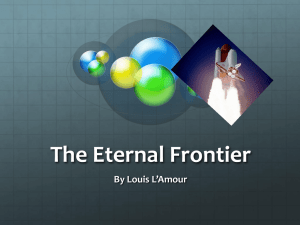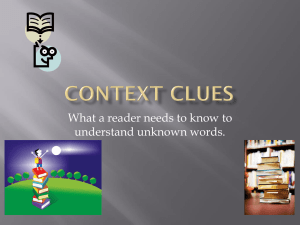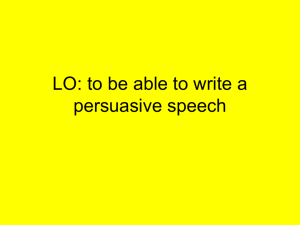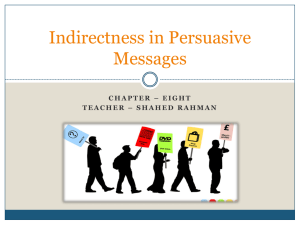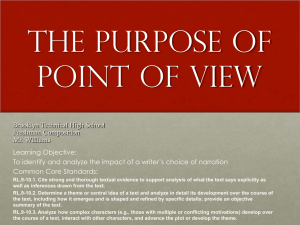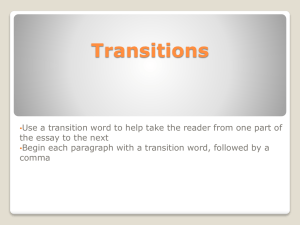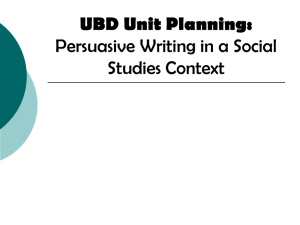STAAR Reading Objective Review
advertisement
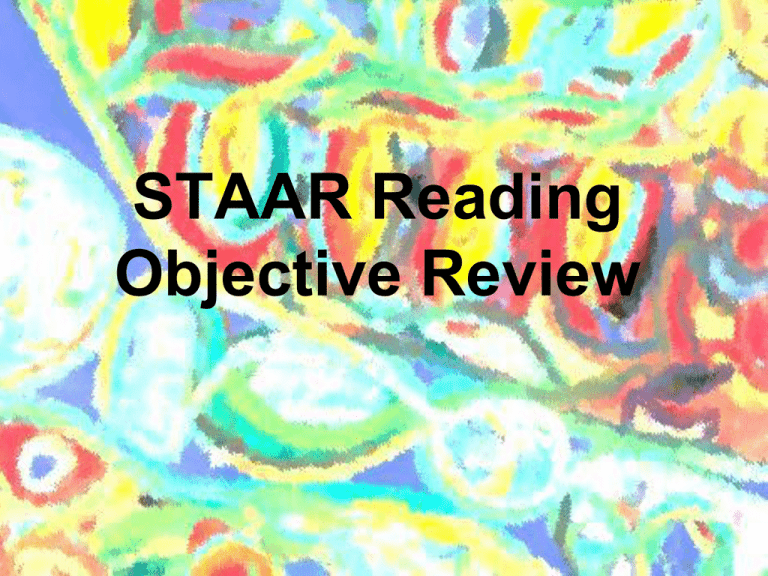
STAAR Reading Objective Review Plot Plot is the literary element that describes the structure of a story. It shows arrangement of events and actions within a story. Plot Components Climax: the turning point, the most intense moment—either mentally or in action Rising Action: the series of conflicts and crisis in the story that lead to the climax Falling Action: all of the action which follows the climax Exposition: the start of the story, the situation before the action starts Resolution: the conclusion, the tying together of all of the threads Topic: Who or what the text is about. Main idea: what the author wants us to know about the topic Supporting Details: the evidence and analysis that supports the main idea. Stated main idea: a general sentence that states exactly what the reader should learn about the topic. Implied main idea: the main idea that is suggested by the supporting details. Author’s Purpose Reasons for Writing Writing to Persuade The MAIN purpose is to convince the reader. Examples Persuasive Essays Persuasive Speeches Persuasive Letters or notes Persuasive writing attempts to change the reader’s mind or get them to do something. Writing to Inform The MAIN purpose is to enlighten the reader. Examples Expository essays Nonfiction texts Instructions or directions Informational writing may be entertaining, but the MAIN purpose is to inform. Writing to Entertain The MAIN purpose is to amuse readers. Examples • Stories • Poems • Plays You may learn something from a story, but the MAIN purpose is to entertain. Reading Skills to remember: Theme – A message about life or human nature that the writer shares with the reader. You may need to infer what the writer’s message is. One way to figure out the theme is to watch for the lessons learned by the main characters to people in real life. Help in finding the THEME! SIGNPOSTS TO NOTICE AND NOTE!! USE THESE STRATEGIES! “AGAIN AND AGAIN” When you notice a word, phrase, or situation mentioned over and over, STOP and ask yourself, “Why does this keep happening again and again?” The answer will tell you about the THEME and CONFLICT, or will foreshadow what might happen later in the story. Help in finding the THEME! SIGNPOSTS TO NOTICE AND NOTE!! USE THESE STRATEGIES! AHA MOMENT When a character realizes, understands, or finally figures out something, STOP and ask yourself, “How might this change things?” If it is about a problem, it tells you something about the CONFLICT; if it is a life lesson, it tells you something about the THEME. Reading Skills to remember: Summarizing – To summarize is to briefly retell the main ideas of a piece of writing in one’s own words. Somebody wanted Characters Plot but Conflict so Resolution Point of View One of the most important decisions a writer makes as they write a story is the narrative point of view he/she will use. The point of view is the narrator’s perspective. Through whose eyes will you, the reader, see the story? FIRST PERSON The reader only knows the thoughts and feelings of the narrator as he or she tells the story through their eyes. First person point of view uses the keywords “I,” “me,” “my,” “we,” “us,” and “our.” THIRD PERSON LIMITED The reader only knows the thoughts and feelings of one main character. Third person limited point of view uses the keywords “he/she,” “him/her,” “they,” “them,” “their,” and the character’s name. THIRD PERSON OMNISCIENT The reader knows the thoughts and feelings of all the main characters (more than one). Omniscient means having total knowledge or knowing everything. Third person omniscient point of view uses the keywords “he/she,” “him/her,” “they,” “them,” “their,” and the characters’ name. NOTE: The keywords are the same as third person limited, so you have to be careful about knowing the difference between 3rd person limited and 3rd person omniscient! Subjective Point of View When writers emphasize or share their own personal feelings, thoughts, judgments, and opinions, their writing is defined as subjective. Objective Point of View Objective writing presents facts and figures only. It does not include the writer’s beliefs or feelings. Warning! Some texts may combine objective writing and subjective writing. For example, a biographer may include his or her opinion of the person about whom he or she is writing, as well as report the facts regarding that person’s life. It is important to recognize which segments are written objectively and which are written subjectively. Organization Passage Organization O Sequence- presentation of the events in the O O O O order they happened. (Transition Words) Compare- tell how things are similar Contrast- tell how things are different Problem/Solution- present a problem of some kind of and then follow up with a resolution or solution to the problem. Cause/Effect- give a reason that something is happening, and then follow up with the effect it will have as a result. Making Generalizations Using what you read & What you already know When you read, you may see ideas about groups of people, animals, or things. What you read & what you already know helps you to make a general statement about a group. This is called a: Generalization . Generalization Key Words Sometimes Always Never Most Many All Generally Valid Generalizations Valid means true. Supported by facts Agrees with what you already know about the topic Uses logic and reasoning Proven with several examples Faulty Generalizations Faulty means false. Not supported by facts Watch for the key words: none, all, always, never, everyone, nobody Context Clues Information (such as a definition, synonym, antonym, or example) that appears near a word or phrase and offers direct or indirect suggestions about its meaning. Types of Context Clues Context clues come in various forms. They may be a definition of the word embedded in the text The factory supervisor demanded an inspection, which is a careful and critical examination of all of the meats processed each day. Types of Context Clues a synonym or antonym in a word, phrase, sentence, or paragraph around the word The boxes weren't exactly heavy, just cumbersome, unlike the easy-tocarry bags with handles. (Here cumbersome can be figured out from its antonym, easy-to-carry.) Types of Context Clues an example that helps define the word The builder decided that the house could be built on a number of sites, for example, along a wooded path, near the ocean, or atop a mountain. Types of Context Clues a restatement of the word or idea Gary Paulsen writes books that appeal, or are of particular interest, to young adult readers. • An inference is something that you conclude based partly on evidence and partly on your own knowledge. • When you make an inference, you read something, add what you know to it, and draw a conclusion. • You put “two and two together” or “read between the lines. What I Read + What I Already Know = What I Infer The girl had tears in her eyes. People with tears in their eyes are often sad. The girl is sad. The house stood at the top of a hill surrounded by twisted, bare trees. The girl shivered in the cold wind and brushed the wet snow from her shoes. She remembered her nice, warm home in Florida with its sandy beaches and warm sunshine. Slowly, she walked toward her new home. How does the girl feel ?? What I Read + The setting creates a dreary, sad, unwanted Mood. 1. Thinks of her old home 2. Walks home slowly What I Know = Already 1. It’s hard to move to a new place. 2. When you move you lose things you care about. What I Infer The girl does not like her new home and prefers her old home. Indirect characterization is when the author SHOWS things that reveal the personality of the character. There are FIVE different methods of Indirect Characterization: Speech Thoughts Effect on other characters Actions Looks (STEAL) Speech- What does the character say? How does the character speak? Example: “Hey, we can have lots of fun at camp this summer! I love being outside!” This shows us the character is upbeat and happy. Thoughts- What is revealed through the character’s thoughts and feelings? Example: I wish it would stop raining. I am tired of sitting inside! This shows us the character is not happy about the situation. Effect on Others- What is revealed through the character’s effect on other people? How do other characters feel or behave in reaction to the character? Example: The boy glared at his sister as she ate his dessert. This shows us that the character is upset about his sister’s behavior and her inability to think of others. Actions- What does the character do? How does the character behave? Example: The girl rode the lawn mower through the house and into the garage. This shows us the girl is not concerned with rules or safety. Looks- What does the character look like? How does the character dress? Example: The little girl left the game with slumped shoulders and a frown on her face. This shows us the little girl is not enjoying herself and is upset. Remember, the difference between direct characterization and indirect characterization is TELLING v. SHOWING! Indirect characterizations are like clues about the characters. There is no mystery with direct characterization because the author gives us the information we need to know! What is Persuasion? A means of convincing people: to buy a certain product to believe something or act in a certain way to agree with a point of view Jennifer Bernhard, Literacy Specialist Clark County Schools Common persuasive techniques often used in advertising Slogan Repetition Bandwagon Testimonial Emotional Appeal Expert Opinion Purpose? Slogan: “Can you hear me now?” A catchy phrase or statement often used to sell a service or a product Repetition: The name of a product is repeated many times HEAD ON Apply directly to the forehead HEAD ON Apply directly to the forehead HEAD ON Apply directly to the forehead Bandwagon A statement suggesting that everyone is using a specific product, so you should too Testimonial A well-known person supports a product or service Emotional Appeal A person is made to have strong feelings about a situation or product Expert opinion Experts approve this product, so you should use it “Four out of five dentists recommend sugarless gum for their patients who chew gum” Audience Awareness Advertisers know how to target their audiences use appropriate persuasive technique Who is the audience? Audience? Audience? Purpose? Persuasive technique? Audience? Purpose? Persuasive technique? Jennifer Bernhard, Literacy Specialist Clark County Schools A great speech, at its heart, is a story well told. Therefore, many literary elements that we are accustomed to seeing in literary pieces are also found in speeches. Below are a few of the most common devices that you may encounter in a speech: Alliteration-the repetition of the beginning sound of a word Parallelism-the repetition of similar types Allusion-a reference to a famous person, historic event, or a work of literature Epigraph-a quote set apart from text Aphorism-a succinct statement of philosophy or principle (usually an aphorism phrases a complex or wise thought in a brief and compelling way)
